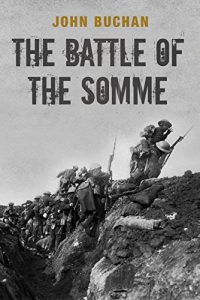On the 1 July, 1916, 20,000 British troops lost their lives during the first day of the Somme.
Artillery had barraged the German lines for seven days, but the Germans were heavily dug in and many shells failed to explode due to the wet ground.
The bombardment signalled to the Germans that the British were coming, so once it had finished they emerged from their fortifications ready to face, and destroy, the enemy offensive.
But the Battle of the Somme was far more than just the 1 July 1916.
The four and a half month battle raged on until November 1916 and saw the introduction of the Tank, the creeping barrage and the development of air power.
Published as a short work just a year after the battle, John Buchan’s account of the first two phases of the Battle of the Somme, one of bloodiest battles of the Great War, leap off the page a century on.
Buchan goes beyond the first day of the Somme to provide a valuable account of the extended battle and the strategy used.
He describes the manoeuvres and the generals who led thousands of troops, and also deliberates on the nature of war and the state of mind needed by the men facing such a terrible battle.
As a war correspondent in France for The Times from 1915 Buchan was well placed to comment on such events.
The Battle of the Somme is a classic contemporary account of the one of the key battles of the First World War by one of the finest writers of the era.
John Buchan, first Baron Tweedsmuir of Elsfield, was born in Perth, Scotland in 1875. In 1900, Buchan moved to London, and two years later accepted a civil service post in South Africa. In the years leading up to World War I, he worked at a publishers, and also wrote Prester John (1910) — which later became a school reader, translated into many languages — as well as a number of biographies. In 1915 he published his most well-known book, the thriller The Thirty-Nine Steps. After the war he became a director of the news agency Reuters. Buchan would eventually publish some one hundred books, forty or so of which were novels, mostly wartime thrillers. In the latter part of his life he worked in politics, serving as Conservative MP for the Scottish universities and Lord High Commissioner of the Church of Scotland (1933-34). In 1935, Buchan moved to Canada, where he became the thirty-fifth Governor General of Canada. He died in 1940, aged 64.
Artillery had barraged the German lines for seven days, but the Germans were heavily dug in and many shells failed to explode due to the wet ground.
The bombardment signalled to the Germans that the British were coming, so once it had finished they emerged from their fortifications ready to face, and destroy, the enemy offensive.
But the Battle of the Somme was far more than just the 1 July 1916.
The four and a half month battle raged on until November 1916 and saw the introduction of the Tank, the creeping barrage and the development of air power.
Published as a short work just a year after the battle, John Buchan’s account of the first two phases of the Battle of the Somme, one of bloodiest battles of the Great War, leap off the page a century on.
Buchan goes beyond the first day of the Somme to provide a valuable account of the extended battle and the strategy used.
He describes the manoeuvres and the generals who led thousands of troops, and also deliberates on the nature of war and the state of mind needed by the men facing such a terrible battle.
As a war correspondent in France for The Times from 1915 Buchan was well placed to comment on such events.
The Battle of the Somme is a classic contemporary account of the one of the key battles of the First World War by one of the finest writers of the era.
John Buchan, first Baron Tweedsmuir of Elsfield, was born in Perth, Scotland in 1875. In 1900, Buchan moved to London, and two years later accepted a civil service post in South Africa. In the years leading up to World War I, he worked at a publishers, and also wrote Prester John (1910) — which later became a school reader, translated into many languages — as well as a number of biographies. In 1915 he published his most well-known book, the thriller The Thirty-Nine Steps. After the war he became a director of the news agency Reuters. Buchan would eventually publish some one hundred books, forty or so of which were novels, mostly wartime thrillers. In the latter part of his life he worked in politics, serving as Conservative MP for the Scottish universities and Lord High Commissioner of the Church of Scotland (1933-34). In 1935, Buchan moved to Canada, where he became the thirty-fifth Governor General of Canada. He died in 1940, aged 64.






